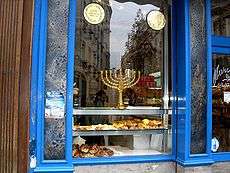Pletzl
|
The "little place", the Jewish quarter in Paris | |
 | |
| Length | 500 m (1,600 ft) |
|---|---|
| Width | 500 m (1,600 ft) |
| Arrondissement | 4th |
| Quarter | Saint-Paul . Le Marais |
| Construction | |
| Completion | 1881 |
| Denomination | The Pletzl |
The Pletzl (פלעצל, "little place" in the Yiddish language) is the Jewish quarter in the fourth arrondissement of Paris, France. The Place Saint-Paul and the surrounding area were, unofficially, named the Pletzl when the neighborhood became predominantly Jewish because of an influx of immigrants at the end of the nineteenth century and the beginning of the twentieth.
When the Parisian Jews were expelled from the city 600 years ago, it was here in the Marais district that they settled. (The Marais was just outside the city wall at the time.) The depth and diversity of the community have grown over the years through immigration from Eastern Europe and North Africa. The area is now characterised by its synagogues, butchers, Jewish delicatessens, and falafel vendors, which provide a social and cultural fabric for its inhabitants.
The darkest days for this community came during the Second World War, when Vichy collaboration with the Nazis resulted in the raids in which many residents were abducted and sent off to death camps. Today, the community is an Orthodox one, extremely religious, and most citizens belong to one of the three local synagogues; one located at 17, rue des Rosiers, another at 25, rue des Rosiers and the one at 10, rue Pavée, an art nouveau temple designed by Hector Guimard, famous for his work on the Paris Métro.
Why Pletzl?
Some time ago, the City of Paris installed a plaque at the corner of the Rue des Rosiers and the Rue Ferdinand Duval that explains why the Jewish quarter is known as the "Pletzl". Translated, it reads:
Fleeing persecution, Ashkenazi Jews flooded into Paris beginning in 1881. They found places living among their co-religionists already established in the Marais. By 1900, about 6,000 had arrived from Rumania, Russia and Austria-Hungary; 18,000 more arrived in the years preceding the First World War. Installed in considerable numbers in the Rue des Écouffes, the Rue Ferdinand Duval (named Rue des Juifs, "Jews Street", until about 1900), and the Rue des Rosiers, they constituted a new community, the "Pletzl", the "little place" in Yiddish, and they created the École Israelite du Travail (Israelite Trade School) at 4B, Rue des Rosiers. The life of this community was evoked in the Roger Ikor novel, Les Eaux Mêlées ("Agitated Waters"), [which won the Prix Goncourt in 1955]. More than half of them perished in the Nazi concentration camps.
Metro station
The Pletzl is:
| Located near the Métro station: Saint-Paul. |
The streets of the Pletzl
- Rue Pavée
- Rue des Rosiers
- Rue Ferdinand Duval
- Rue des Écouffes
- Rue des Hospitalières-Saint-Gervais
- Rue Vieille du Temple
Notable attractions
- L'As du Fallafel - a popular Kosher Middle Eastern restaurant located on rue de Rosiers known for its acclaimed falafel sandwich.[1]
- Synagogue at 17 rue de Rosiers, fondly known as "Zibetzin" (lit. 17) which was frequented by many of the Chabad-Lubavitch rebbes during their time in Paris.[2]
Bibliography
- Etude remarquable de Nancy Green : The Pletzl of Paris : Jewish immigrant workers in the Belle époque, New York ; London : Holmes and Meier, 1986, IX-270 p. ; éd. fr., Les Travailleurs immigrés juifs à la Belle époque : le " Pletzl " de Paris, Paris, Fayard, 1985, 360 p.
References
- ↑ Mark Bittman (31 December 2006). "Paris: L'As du Fallafel". New York Times. Retrieved 15 April 2011.
- ↑ Menachem Posner (5 October 2014). "Making the Grade in Paris: Sinai Schools Impart Jewish Values and Life Lessons". Chabad.org. Retrieved 3 January 2015.
Gallery
 "Jo Goldenberg", a restaurant closed since 2007
"Jo Goldenberg", a restaurant closed since 2007_01.jpg) The Jewish restaurant, "Chez Marianne"
The Jewish restaurant, "Chez Marianne" Another restaurant
Another restaurant A Jewish shop
A Jewish shop A store in the Pletzl
A store in the Pletzl
 A Jewish bakery in the Rue des Écouffes
A Jewish bakery in the Rue des Écouffes Another Jewish bakery in the Rue des Rosiers
Another Jewish bakery in the Rue des Rosiers
| Wikimedia Commons has media related to Le Marais. |
| Wikimedia Commons has media related to Category:Pletzl. |
Coordinates: 48°51′25.24″N 2°21′34.79″E / 48.8570111°N 2.3596639°E

